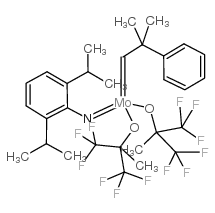139220-25-0
| Name | [2,6-di(propan-2-yl)phenyl]imino-(2-methyl-2-phenylpropylidene)molybdenum,1,1,1,3,3,3-hexafluoro-2-methylpropan-2-ol |
|---|---|
| Synonyms |
Mo(N(2,6-iPrC6H3))(CHCMe2Ph)(OCMe(CF3)2)2
{(2-methyl-2-phenyl-propylidene)((2,6-diisopropylphenyl)imido)molybdenum(VI)bis(hexafluoro-tert-butoxide)} SCHROCK'S CATALYST 2,6-Diisopropylphenylimidoneophylidene molybdenum(VI) bis(hexafluoro-t-butoxide) SCHROCK'S CATALYST Mo(N-2,6-iPr2C6H3)(CHCMe2Ph)(OCMe(CF3)2)2 2,6-DIISOPROPYLPHENYLIMIDO NEOPHYLIDENEMOLYBDENUM(VI) BIS(HEXAFLUORO-T-BUTOXIDE) (2,6-diisopropylphenylimidoneophylidenemolybdenium (VI) bis(hexafluorotert-butoxide)) |
| Molecular Formula | C30H35F12MoNO2 |
|---|---|
| Molecular Weight | 765.54500 |
| Exact Mass | 767.15300 |
| PSA | 30.82000 |
| LogP | 11.31470 |
|
Section 1: Product Identification 2,6-Diisopropylphenylimido neophylidenemolybdenum(VI) bis(hexafluoro-t-butoxide) SCHROCK'S CATALYST Chemical Name: CAS Registry Number:139220-25-0 Formula:Mo(C10H12)(C12H17N)[OC(CH3)(CF3)2]2 EINECS Number:none Chemical Family:organometallic complexes
Synonym:Schrock's catalyst Section 2: Composition and Information on Ingredients IngredientCAS NumberPercentACGIH (TWA)OSHA (PEL) Title compound139220-25-0100%10mg/m3( as Mo)15mg/m3 (as Mo) Section 3: Hazards Identification Emergency Overview:May be irritating to skin, eyes and mucous membranes. Primary Routes of Exposure:Ingestion, inhalation Eye Contact:May cause mild to moderate irritation of the eyes. Skin Contact:May cause slight to mild irritation of the skin. Inhalation:Dust may be irritating to the nose, mucous membranes and respiratory tract. Ingestion:No specific information is available on the physiological effects of ingestion. Acute Health Affects:Dust may be irritating to skin, eyes and respiratory tract. No information available on long-term chronic effects. Product contains fluorine which may generate fluoride Chronic Health Affects: ion causing hypocalcaemia, deterioration of bone and tooth structure, kidney and liver damage. NTP:No IARC:No OSHA:No SECTION 4: First Aid Measures Immediately flush the eyes with copious amounts of water for at least 10-15 minutes. A victim may need Eye Exposure: assistance in keeping their eye lids open. Get immediate medical attention. Wash the affected area with water. Remove contaminated clothes if necessary. Seek medical assistance if Skin Exposure: irritation persists. Remove the victim to fresh air. Closely monitor the victim for signs of respiratory problems, such as difficulty in Inhalation: breathing, coughing, wheezing or pain. In such cases seek immediate medical assistance. Seek medical attention immediately. Keep the victim calm. Give the victim water (only if conscious). Induce Ingestion: vomiting only if directed by medical personnel. SECTION 5: Fire Fighting Measures Flash Point:no data Autoignition Temperature:no data Explosion Limits:no data Extinguishing Medium:carbon dioxide, dry powder or foam. If involved in a fire, fire fighters should be equipped with NIOSH approved positive pressure self-contained Special Fire Fighting Procedures: breathing apparatus and full protective clothing. Hazardous Combustion andIf involved in a fire this material may emit toxic organic fumes. Decomposion Products: Unusual Fire or Explosion Hazards: No unusual fire or explosion hazards. SECTION 6: Accidental Release Measures Small spills can be mixed with vermiculite, sodium carbonate or other suitable non combustible adsorbent and Spill and Leak Procedures: swept up. SECTION 7: Handling and Storage Handling and Storage:Handle and store the material under an inert atmosphere of nitrogen or argon. Keep away from heat. SECTION 8: Exposure Controls and Personal Protection Eye Protection:Always wear approved safety glasses when handling a chemical substance in the laboratory. Skin Protection:Wear protective clothing and gloves. Ventilation:Material may form a fine dust. If possible, handle the material in an efficient fume hood. If ventilation is not available a respirator should be worn. The use of respirators requires a Respiratory Respirator: Protection Program to be in compliance with 29 CFR 1910.134. Ventilation:Material may form a fine dust. If possible, handle the material in an efficient fume hood. Additional Protection:No additional protection required. SECTION 9: Physical and Chemical Properties Color and Form:yellow to orange powder Molecular Weight:765.53 Melting Point:no data Boiling Point:no data Vapor Pressure:no data Specific Gravity:no data Odor:not determined Solubility in Water:reacts with water SECTION 10: Stability and Reactivity Stability:air and moisture sensitive (store cold) Hazardous Polymerization:No hazardous polymerization. Conditions to Avoid:contact with air and moisture Incompatibility:oxidizing agents and halogens Decomposition Products:carbon monoxide, carbon dioxide, organic fumes and molybdenum oxide. SECTION 11: Toxicological Information RTECS Data:No information available in the RTECS files. Carcinogenic Effects:no data Mutagenic Effects:no data Tetratogenic Effects:no data SECTION 12: Ecological Information Ecological Information:No information available SECTION 13: Disposal Considerations Disposal:Dispose of according to local, state and federal regulations. SECTION 14: Transportation Shipping Name (CFR):Non-hazardous Hazard Class (CFR):NA Additional Hazard Class (CFR):NA Packaging Group (CFR):NA UN ID Number (CFR):NA Shipping Name (IATA):Non-hazardous Hazard Class (IATA):NA Additional Hazard Class (IATA):NA Packaging Group (IATA):NA UN ID Number (IATA):NA SECTION 15: Regulatory Information TSCA:Not listed in the TSCA inventory SARA (Title 313):Title compound not listed. Second Ingredient:none SECTION 16 - ADDITIONAL INFORMATION N/A |
| Risk Phrases | 36/37/38 |
|---|---|
| Safety Phrases | 26-36/37/39 |
